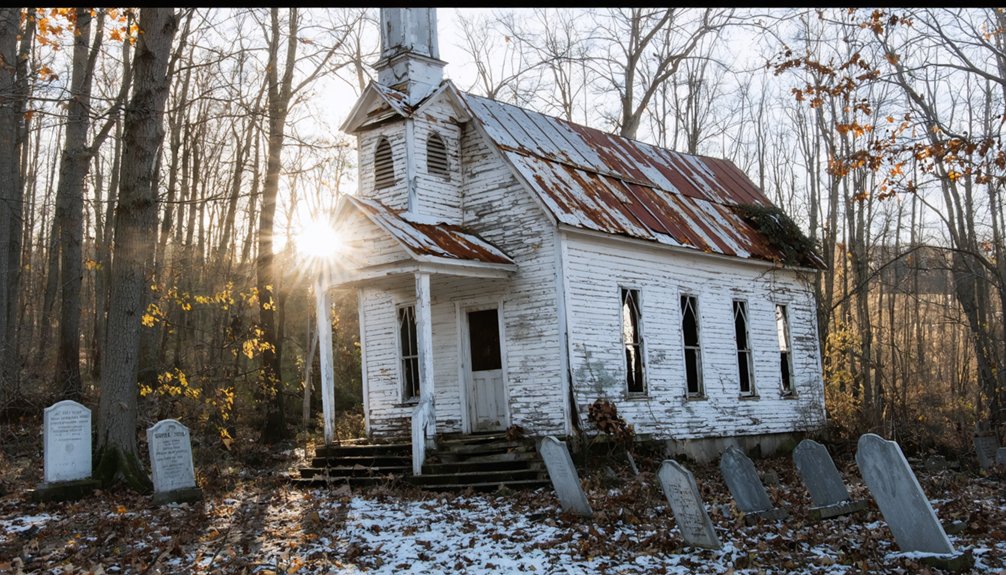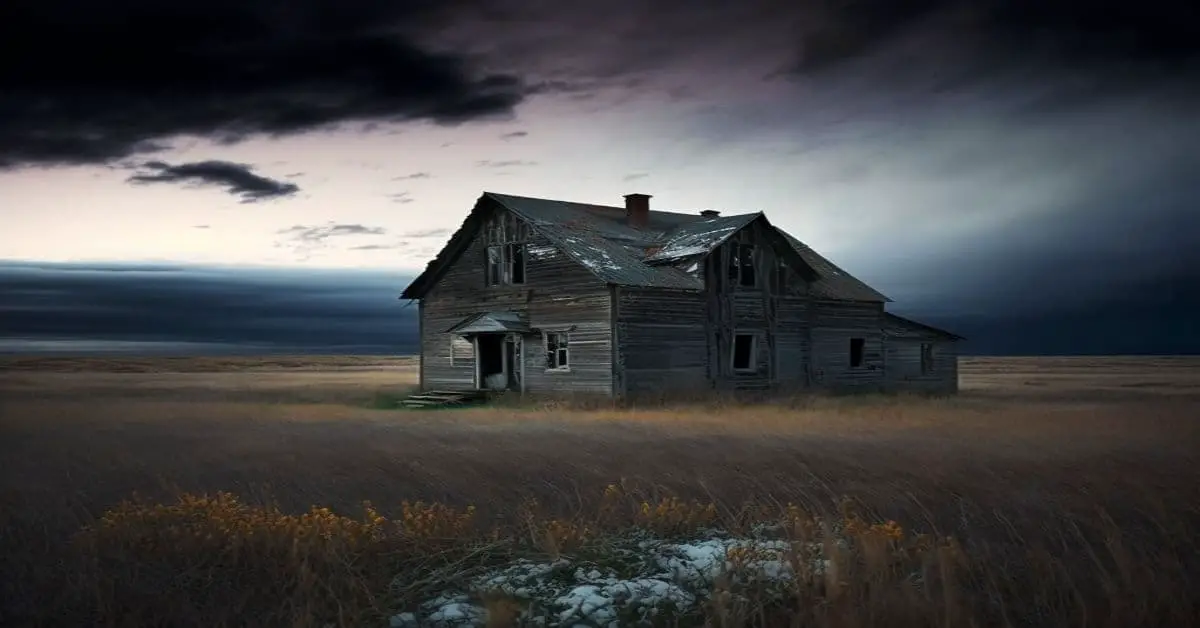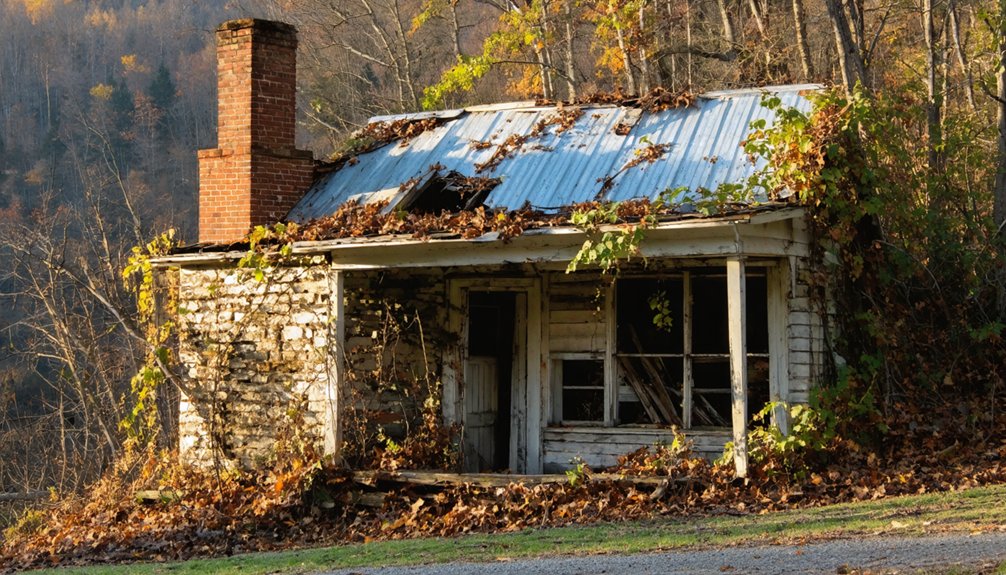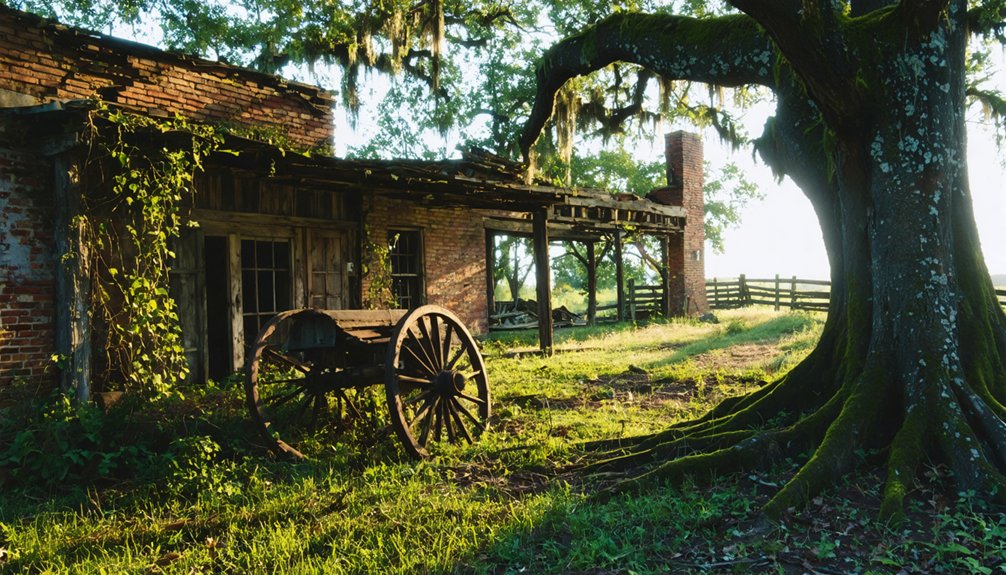You’ll find Snowball, Arkansas along State Highway 74, where a once-bustling Ozark Mountain town of 500 residents now stands frozen in time. The town’s notable structures include the historic Masonic Hall and remnants of early grist mills, while its cultural legacy lives on through Jimmy Driftwood, who served as the local school’s principal. A devastating 1945 fire, followed by economic decline and school consolidation, transformed this community into a ghost town that holds countless untold stories.
Key Takeaways
- Snowball was once a thriving community established in 1837, but declined after a 1912 stave mill relocation and devastating 1945 fire.
- The town’s population shrank from 500 residents, with the post office closing in 1966 and school consolidating with Marshall in the 1970s.
- Notable musician Jimmy Driftwood served as Snowball School’s principal and helped preserve local folk traditions through music and cultural initiatives.
- Historic structures still standing include the Masonic Hall and an old church building, offering glimpses into early Ozark life.
- Located along State Highway 74, Snowball’s abandoned buildings and ruins are mostly on private property, requiring permission for exploration.
The Birth and Early Days of a Rural Arkansas Town
While many Arkansas settlements grew organically around natural resources or trade routes, Snowball’s origin story centers on a clerical error that transformed “Snow Hall” into the town’s peculiar name in 1888.
You’ll find the roots of this Ozark community stretching back to 1837, when John Campbell became the first white settler in what was then called Calf Creek.
Early settlers established critical infrastructure, including a grist mill and cotton gin, while community organization flourished with the founding of Calf Creek Masonic Lodge No. 426 in 1885.
The lodge’s building, named Snow Hall after Sheriff Benjamin Franklin Snow, became the heart of local activity, receiving only 5.5 inches of annual snowfall despite its wintry name.
The lodge’s building, named Snow Hall after Sheriff Benjamin Franklin Snow, became the heart of local activity.
Bill Taylor’s store and A. R. Bradley’s hotel soon followed, creating a small but vibrant business district that would thrive until a significant fire in 1945 destroyed many local establishments.
From Boom to Bust: The Town’s Gradual Decline
Despite its promising early growth, Snowball’s decline began with the 1912 stave mill‘s relocation to Marshall, marking the first major blow to the town’s economic foundation.
The stave mill’s departure in 1912 marked the beginning of Snowball’s slow fade from thriving town to forgotten community.
Much like Pinnacle Springs, the town’s fate was sealed by dwindling economic prospects and changing times.
The abandoned WPA school building stood as a stark reminder of better days until its destruction by fire in the 1980s.
As economic shifts rippled through the community, you’d have witnessed the gradual erosion of local businesses and services that once supported a population of 500 residents.
The devastating 1945 fire accelerated this downward spiral, destroying most of the business district and triggering significant community migration.
You can trace the town’s continued decline through the closure of essential institutions: the post office in 1966, the school’s consolidation with Marshall in the 1970s, and the eventual shutdown of the gymnasium-turned-civic center.
Even a brief revival attempt by back-to-the-land settlers in the 1970s couldn’t reverse Snowball’s path toward ghost town status.
Notable Landmarks and Remaining Structures
The scattered remnants of Snowball’s past dot the quiet Ozark landscape today, with the Masonic Hall standing as one of the few intact historic structures from the town’s heyday.
You’ll find an old church building that once served dual purposes as both a place of worship and community gathering spot.
Near Calf Creek, you can explore the sites of early grist mills and Benjamin Taylor’s steam-powered mill ruins.
Cooper’s Bluff, listed on the National Register of Historic Places, preserves evidence of prehistoric Native American presence in the area.
While most commercial buildings have vanished or crumbled, you’ll discover traditional Ozark Mountain homes scattered throughout the region, along with unmarked pioneer homestead sites that hint at the area’s rich settling history.
The 1938 WPA building remains one of the most significant architectural examples of the town’s educational heritage.
Much like Monte Ne’s underwater ruins, several original structures now lie beneath the waters of nearby Beaver Lake, submerged during the 1960s flooding.
Cultural Heritage and Jimmy Driftwood’s Legacy
Among the most influential figures in Ozark cultural history, Jimmy Driftwood transformed Snowball’s legacy through his multifaceted contributions as an educator, folk musician, and preservationist.
As Snowball School‘s principal after 1949, he pioneered using songwriting to teach American history, crafting “The Battle of New Orleans” to help students remember historical events. His dedication to education began early when he taught in one-room schoolhouses while still attending high school in Mountain View. His connection to education deepened when he received an honorary doctorate degree from George Peabody College in 1959.
Driftwood’s influence extended far beyond the classroom. You’ll find his impact in the Ozark Folk Center State Park, which he helped establish with $2.1 million in federal funding, and the Arkansas Folk Festival in Mountain View.
Driftwood’s vision lives on at the Ozark Folk Center State Park, preserving cultural heritage through federal support and community festivals.
He co-founded the Rackensack Folklore Society to preserve folk traditions and fought to protect the Buffalo River.
His musical legacy lives on through over 6,000 songs and his Grammy-winning achievements, while his barn in Mountain View continues to showcase authentic Ozark folk music.
Exploring the Ghost Town Today
Standing as a reflection of Arkansas’s past, Snowball’s remaining structures offer visitors a glimpse into early Ozark life. As you venture along State Highway 74, about 13 miles west of Marshall, you’ll discover abandoned buildings that tell stories of a once-thriving community.
The historic Masonic Hall and old church building remain as anchors of this ghost town’s heritage. The town was once home to the successful OK Cementers baseball team. Located in the region that contains Monte Ne, the area offers rich opportunities for historical exploration.
When planning your historical exploration, remember:
- You’ll need permission to access certain areas, as much of Snowball sits on private property.
- The deteriorating structures require careful navigation for safety.
- There’s minimal signage, so bring maps and research materials.
You can still trace the town’s original layout through visible street patterns and building foundations, while remnants of cotton gins and mills reveal Snowball’s industrial past.
Frequently Asked Questions
Are There Any Reported Ghost Sightings or Paranormal Activity in Snowball?
You won’t find documented ghost encounters or paranormal investigations in Snowball. Despite the town’s abandoned buildings and historical fires, no credible supernatural activity has been officially reported or verified.
What Happened to the Original Town Records After the 1945 Fire?
You won’t find clear answers about Snowball’s town archives after the 1945 blaze. Like many frontier communities that faced devastating fires, the records likely perished or scattered during the fire aftermath.
Can Visitors Legally Explore Inside the Remaining Abandoned Buildings?
You can’t legally explore inside abandoned structures without explicit owner permission. Most buildings are on private property, and unauthorized entry constitutes trespassing. Legal exploration is limited to external viewing only.
What Wildlife Now Inhabits the Abandoned Areas of Snowball?
You’ll encounter diverse wildlife species including black bears, deer, coyotes, bats in old mines, wild turkeys, and various songbirds thriving in the ecological impact of nature reclaiming abandoned structures.
Does Anyone Still Maintain Family Graves in the Local Cemetery?
While countless graves lie forgotten in time, you’ll find dedicated descendants occasionally return to maintain family heritage through grave maintenance, though most plots remain untended in this remote cemetery.
References
- https://aymag.com/arkansas-backstories-snowball/
- https://trekkermom.wordpress.com/2015/08/26/snowball-arkansas/
- https://abandonedar.com/city/northern-arkansas/snowball/
- https://encyclopediaofarkansas.net/media/abandoned-home-13916/
- https://www.ualrpublicradio.org/2021-04-30/encyclopedia-of-arkansas-minute-snowball-arkansas
- https://www.arkansasheritage.com/arkansas-register/snowball-gymnasium
- https://encyclopediaofarkansas.net/county/searcy/
- https://abandonedar.com/snowball-school-and-gym/
- https://aymag.com/arkansas-backstories-ghost-towns/
- https://digging-history.com/2015/06/10/ghost-town-wednesday-rush-arkansas/



